In-Depth Analysis: Wound Care Management Strategies and Complications
VerifiedAdded on 2023/06/03
|27
|6555
|458
Report
AI Summary
This report provides a comprehensive overview of wound care management in nursing practice. It addresses strategies to minimize cross-infection, the rationale for extended dressing periods, and a holistic approach to patient assessment using the H.E.I.D.I. framework. The report also explores the psychological considerations affecting wound healing, common wound complications, and effective communication strategies for discussing infection risks with patients and their families. Furthermore, it details essential elements of ballistic wound assessment, intrinsic and extrinsic factors influencing wound healing, and the roles of various healthcare professionals in wound care. The report also emphasizes the importance of professional development for nurses, adherence to NSQHS standards, and the documentation required for comprehensive wound management. Finally, it discusses debridement techniques, phases of bacterial growth, aseptic techniques, and suture removal procedures.
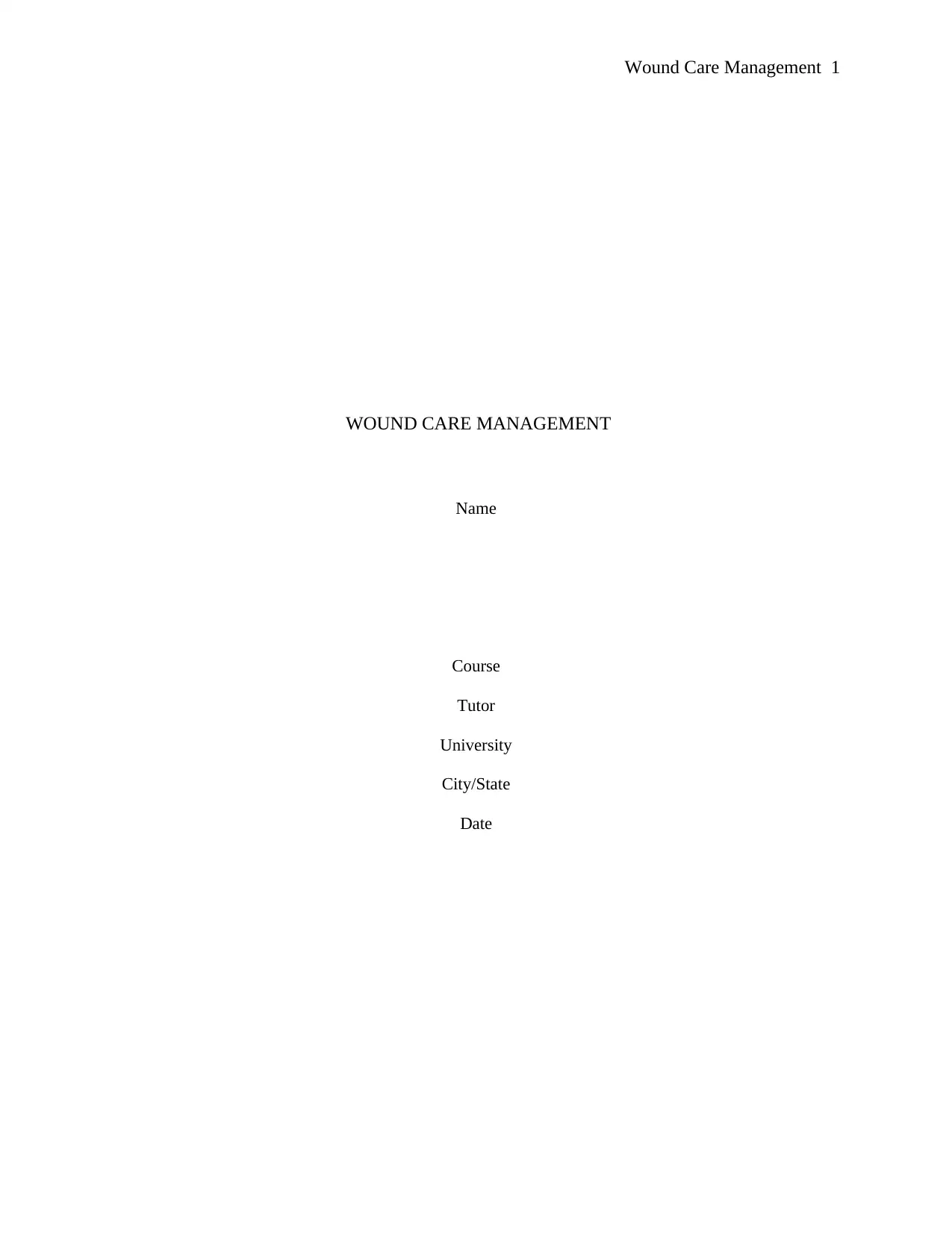
Wound Care Management 1
WOUND CARE MANAGEMENT
Name
Course
Tutor
University
City/State
Date
WOUND CARE MANAGEMENT
Name
Course
Tutor
University
City/State
Date
Paraphrase This Document
Need a fresh take? Get an instant paraphrase of this document with our AI Paraphraser
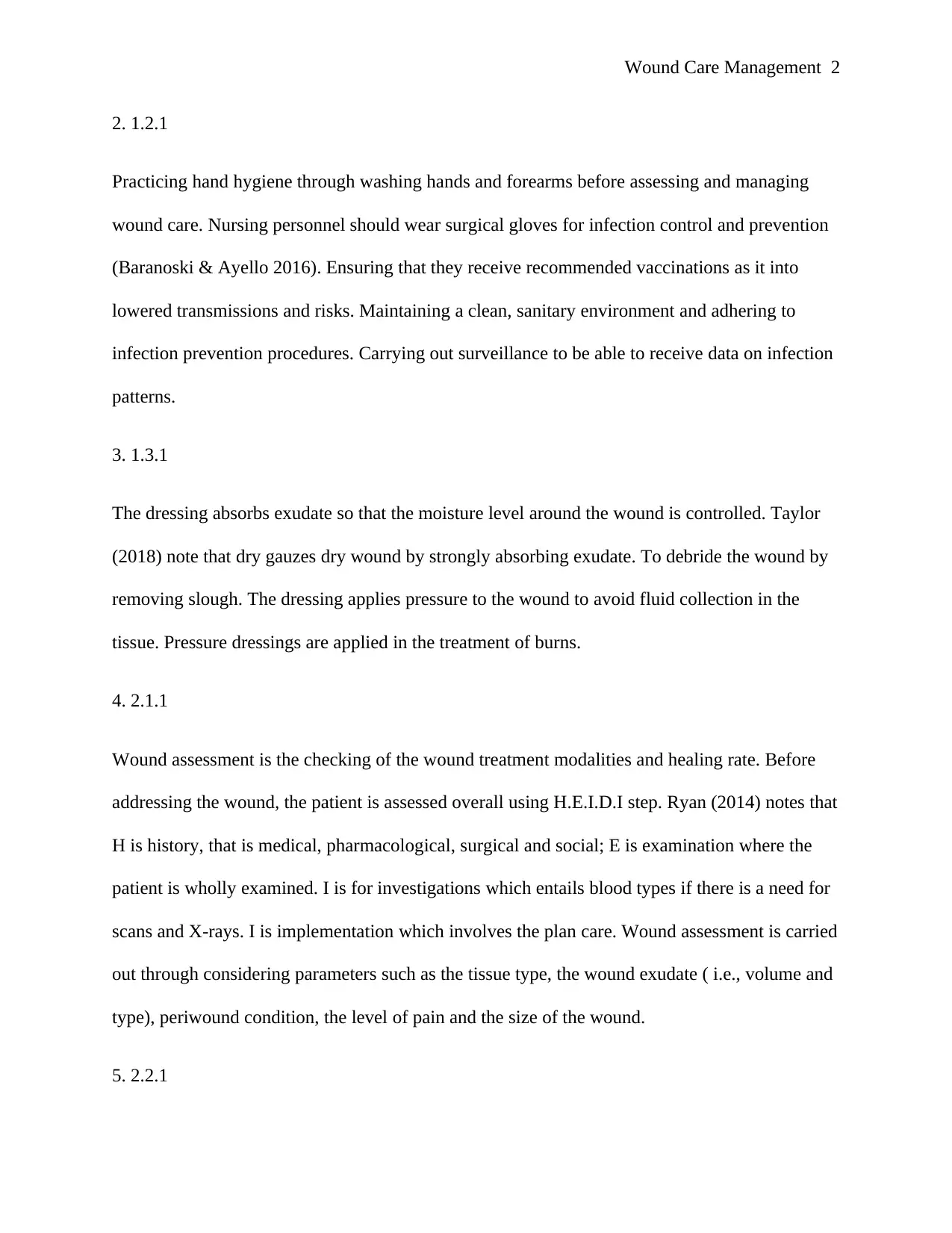
Wound Care Management 2
2. 1.2.1
Practicing hand hygiene through washing hands and forearms before assessing and managing
wound care. Nursing personnel should wear surgical gloves for infection control and prevention
(Baranoski & Ayello 2016). Ensuring that they receive recommended vaccinations as it into
lowered transmissions and risks. Maintaining a clean, sanitary environment and adhering to
infection prevention procedures. Carrying out surveillance to be able to receive data on infection
patterns.
3. 1.3.1
The dressing absorbs exudate so that the moisture level around the wound is controlled. Taylor
(2018) note that dry gauzes dry wound by strongly absorbing exudate. To debride the wound by
removing slough. The dressing applies pressure to the wound to avoid fluid collection in the
tissue. Pressure dressings are applied in the treatment of burns.
4. 2.1.1
Wound assessment is the checking of the wound treatment modalities and healing rate. Before
addressing the wound, the patient is assessed overall using H.E.I.D.I step. Ryan (2014) notes that
H is history, that is medical, pharmacological, surgical and social; E is examination where the
patient is wholly examined. I is for investigations which entails blood types if there is a need for
scans and X-rays. I is implementation which involves the plan care. Wound assessment is carried
out through considering parameters such as the tissue type, the wound exudate ( i.e., volume and
type), periwound condition, the level of pain and the size of the wound.
5. 2.2.1
2. 1.2.1
Practicing hand hygiene through washing hands and forearms before assessing and managing
wound care. Nursing personnel should wear surgical gloves for infection control and prevention
(Baranoski & Ayello 2016). Ensuring that they receive recommended vaccinations as it into
lowered transmissions and risks. Maintaining a clean, sanitary environment and adhering to
infection prevention procedures. Carrying out surveillance to be able to receive data on infection
patterns.
3. 1.3.1
The dressing absorbs exudate so that the moisture level around the wound is controlled. Taylor
(2018) note that dry gauzes dry wound by strongly absorbing exudate. To debride the wound by
removing slough. The dressing applies pressure to the wound to avoid fluid collection in the
tissue. Pressure dressings are applied in the treatment of burns.
4. 2.1.1
Wound assessment is the checking of the wound treatment modalities and healing rate. Before
addressing the wound, the patient is assessed overall using H.E.I.D.I step. Ryan (2014) notes that
H is history, that is medical, pharmacological, surgical and social; E is examination where the
patient is wholly examined. I is for investigations which entails blood types if there is a need for
scans and X-rays. I is implementation which involves the plan care. Wound assessment is carried
out through considering parameters such as the tissue type, the wound exudate ( i.e., volume and
type), periwound condition, the level of pain and the size of the wound.
5. 2.2.1
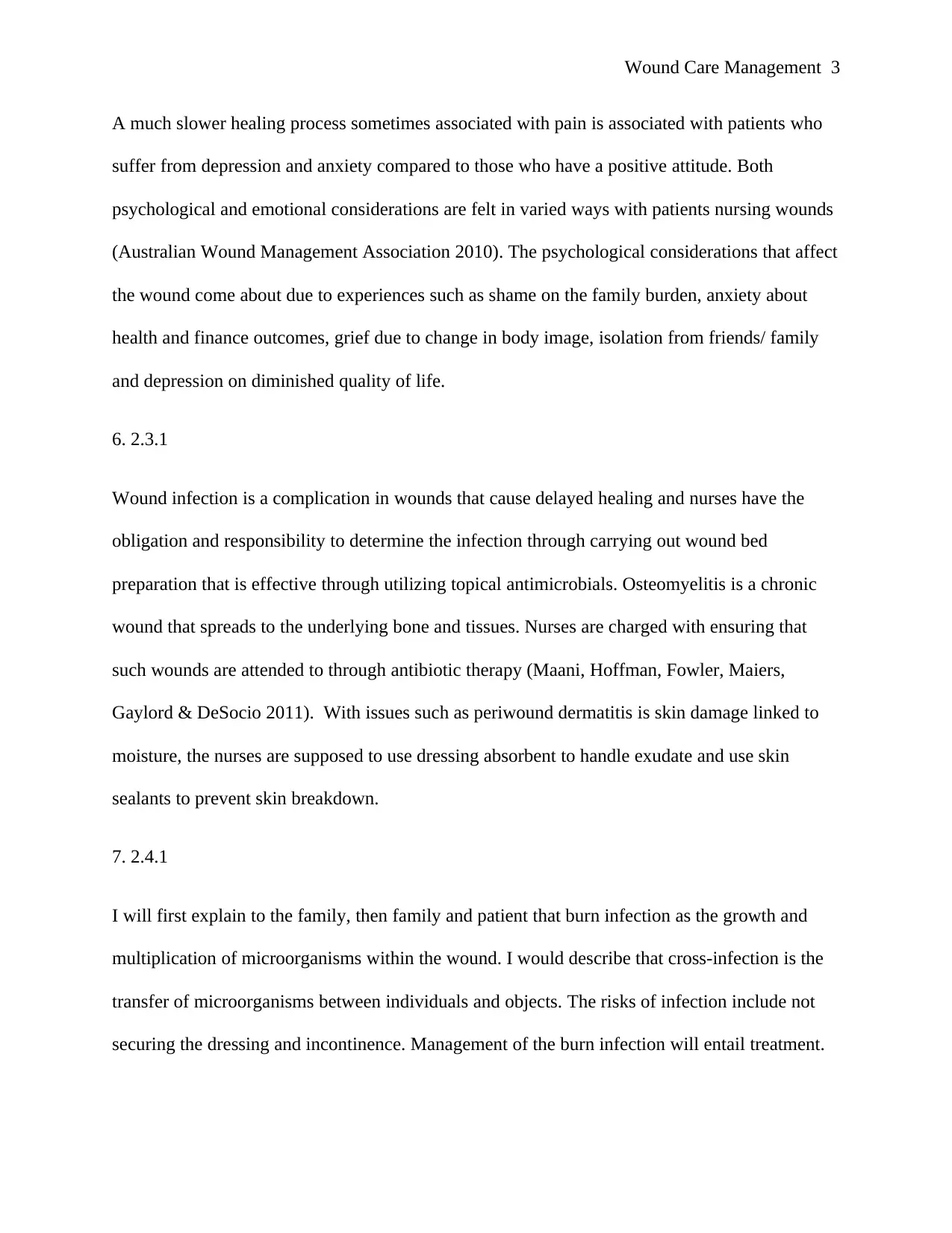
Wound Care Management 3
A much slower healing process sometimes associated with pain is associated with patients who
suffer from depression and anxiety compared to those who have a positive attitude. Both
psychological and emotional considerations are felt in varied ways with patients nursing wounds
(Australian Wound Management Association 2010). The psychological considerations that affect
the wound come about due to experiences such as shame on the family burden, anxiety about
health and finance outcomes, grief due to change in body image, isolation from friends/ family
and depression on diminished quality of life.
6. 2.3.1
Wound infection is a complication in wounds that cause delayed healing and nurses have the
obligation and responsibility to determine the infection through carrying out wound bed
preparation that is effective through utilizing topical antimicrobials. Osteomyelitis is a chronic
wound that spreads to the underlying bone and tissues. Nurses are charged with ensuring that
such wounds are attended to through antibiotic therapy (Maani, Hoffman, Fowler, Maiers,
Gaylord & DeSocio 2011). With issues such as periwound dermatitis is skin damage linked to
moisture, the nurses are supposed to use dressing absorbent to handle exudate and use skin
sealants to prevent skin breakdown.
7. 2.4.1
I will first explain to the family, then family and patient that burn infection as the growth and
multiplication of microorganisms within the wound. I would describe that cross-infection is the
transfer of microorganisms between individuals and objects. The risks of infection include not
securing the dressing and incontinence. Management of the burn infection will entail treatment.
A much slower healing process sometimes associated with pain is associated with patients who
suffer from depression and anxiety compared to those who have a positive attitude. Both
psychological and emotional considerations are felt in varied ways with patients nursing wounds
(Australian Wound Management Association 2010). The psychological considerations that affect
the wound come about due to experiences such as shame on the family burden, anxiety about
health and finance outcomes, grief due to change in body image, isolation from friends/ family
and depression on diminished quality of life.
6. 2.3.1
Wound infection is a complication in wounds that cause delayed healing and nurses have the
obligation and responsibility to determine the infection through carrying out wound bed
preparation that is effective through utilizing topical antimicrobials. Osteomyelitis is a chronic
wound that spreads to the underlying bone and tissues. Nurses are charged with ensuring that
such wounds are attended to through antibiotic therapy (Maani, Hoffman, Fowler, Maiers,
Gaylord & DeSocio 2011). With issues such as periwound dermatitis is skin damage linked to
moisture, the nurses are supposed to use dressing absorbent to handle exudate and use skin
sealants to prevent skin breakdown.
7. 2.4.1
I will first explain to the family, then family and patient that burn infection as the growth and
multiplication of microorganisms within the wound. I would describe that cross-infection is the
transfer of microorganisms between individuals and objects. The risks of infection include not
securing the dressing and incontinence. Management of the burn infection will entail treatment.
⊘ This is a preview!⊘
Do you want full access?
Subscribe today to unlock all pages.

Trusted by 1+ million students worldwide
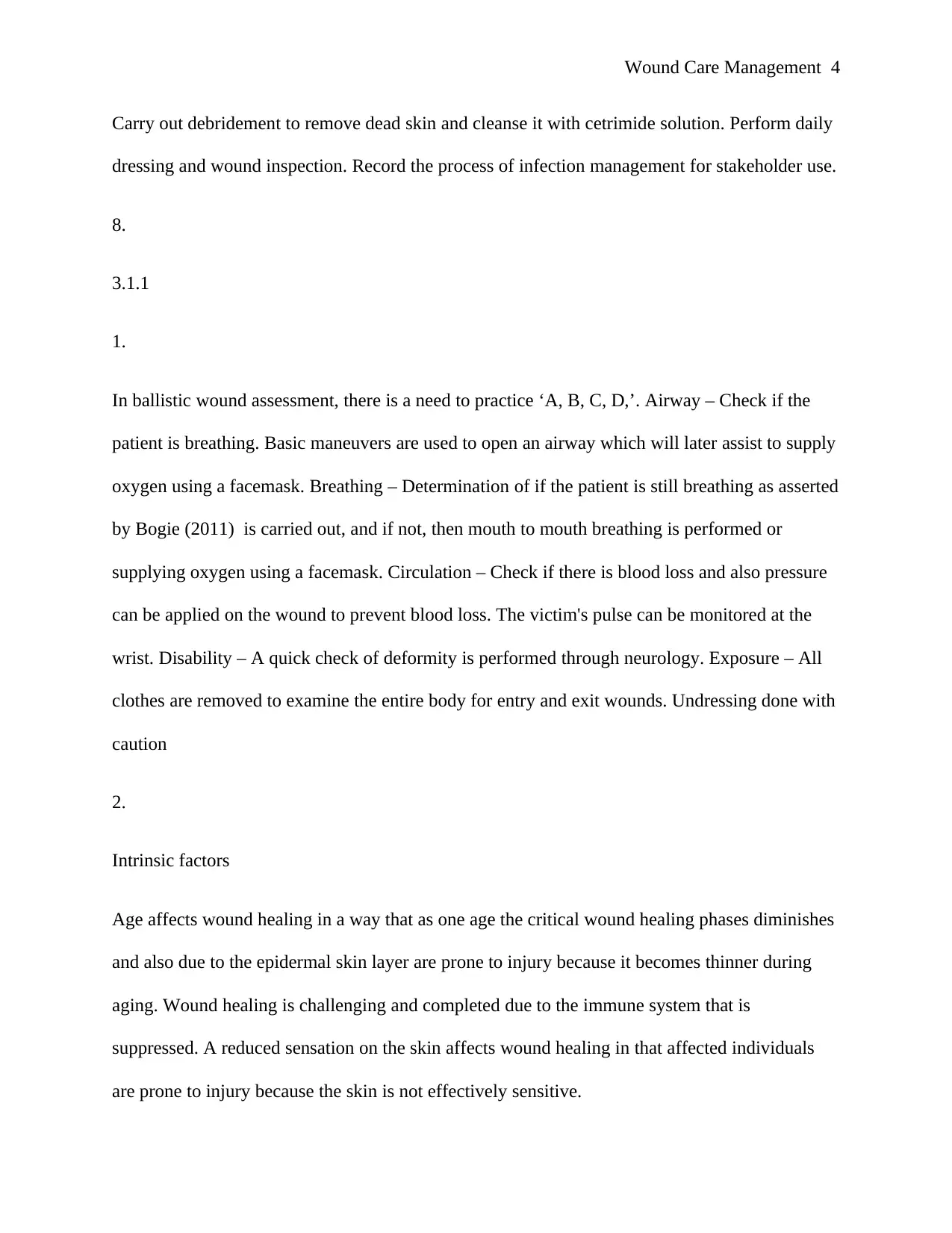
Wound Care Management 4
Carry out debridement to remove dead skin and cleanse it with cetrimide solution. Perform daily
dressing and wound inspection. Record the process of infection management for stakeholder use.
8.
3.1.1
1.
In ballistic wound assessment, there is a need to practice ‘A, B, C, D,’. Airway – Check if the
patient is breathing. Basic maneuvers are used to open an airway which will later assist to supply
oxygen using a facemask. Breathing – Determination of if the patient is still breathing as asserted
by Bogie (2011) is carried out, and if not, then mouth to mouth breathing is performed or
supplying oxygen using a facemask. Circulation – Check if there is blood loss and also pressure
can be applied on the wound to prevent blood loss. The victim's pulse can be monitored at the
wrist. Disability – A quick check of deformity is performed through neurology. Exposure – All
clothes are removed to examine the entire body for entry and exit wounds. Undressing done with
caution
2.
Intrinsic factors
Age affects wound healing in a way that as one age the critical wound healing phases diminishes
and also due to the epidermal skin layer are prone to injury because it becomes thinner during
aging. Wound healing is challenging and completed due to the immune system that is
suppressed. A reduced sensation on the skin affects wound healing in that affected individuals
are prone to injury because the skin is not effectively sensitive.
Carry out debridement to remove dead skin and cleanse it with cetrimide solution. Perform daily
dressing and wound inspection. Record the process of infection management for stakeholder use.
8.
3.1.1
1.
In ballistic wound assessment, there is a need to practice ‘A, B, C, D,’. Airway – Check if the
patient is breathing. Basic maneuvers are used to open an airway which will later assist to supply
oxygen using a facemask. Breathing – Determination of if the patient is still breathing as asserted
by Bogie (2011) is carried out, and if not, then mouth to mouth breathing is performed or
supplying oxygen using a facemask. Circulation – Check if there is blood loss and also pressure
can be applied on the wound to prevent blood loss. The victim's pulse can be monitored at the
wrist. Disability – A quick check of deformity is performed through neurology. Exposure – All
clothes are removed to examine the entire body for entry and exit wounds. Undressing done with
caution
2.
Intrinsic factors
Age affects wound healing in a way that as one age the critical wound healing phases diminishes
and also due to the epidermal skin layer are prone to injury because it becomes thinner during
aging. Wound healing is challenging and completed due to the immune system that is
suppressed. A reduced sensation on the skin affects wound healing in that affected individuals
are prone to injury because the skin is not effectively sensitive.
Paraphrase This Document
Need a fresh take? Get an instant paraphrase of this document with our AI Paraphraser
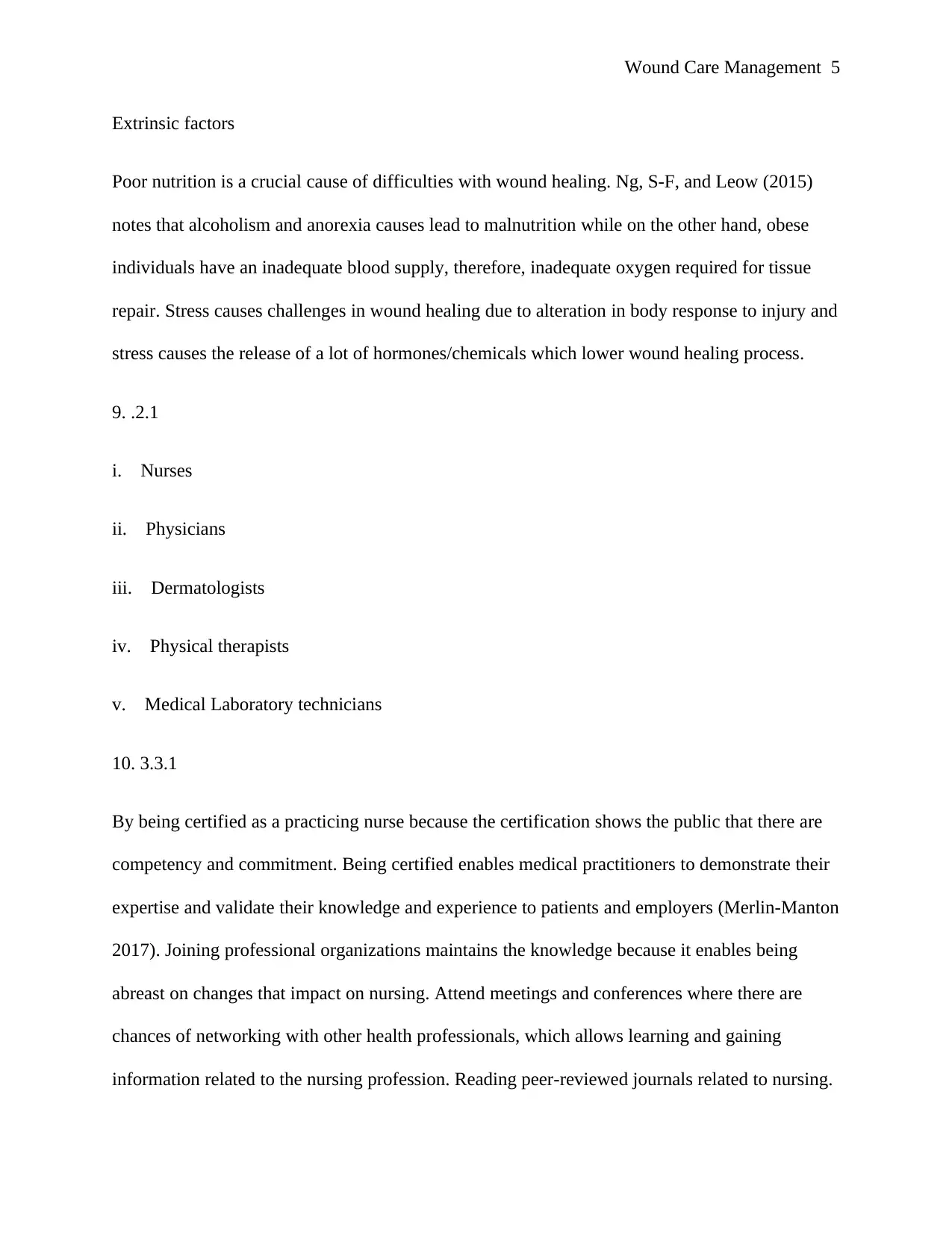
Wound Care Management 5
Extrinsic factors
Poor nutrition is a crucial cause of difficulties with wound healing. Ng, S-F, and Leow (2015)
notes that alcoholism and anorexia causes lead to malnutrition while on the other hand, obese
individuals have an inadequate blood supply, therefore, inadequate oxygen required for tissue
repair. Stress causes challenges in wound healing due to alteration in body response to injury and
stress causes the release of a lot of hormones/chemicals which lower wound healing process.
9. .2.1
i. Nurses
ii. Physicians
iii. Dermatologists
iv. Physical therapists
v. Medical Laboratory technicians
10. 3.3.1
By being certified as a practicing nurse because the certification shows the public that there are
competency and commitment. Being certified enables medical practitioners to demonstrate their
expertise and validate their knowledge and experience to patients and employers (Merlin-Manton
2017). Joining professional organizations maintains the knowledge because it enables being
abreast on changes that impact on nursing. Attend meetings and conferences where there are
chances of networking with other health professionals, which allows learning and gaining
information related to the nursing profession. Reading peer-reviewed journals related to nursing.
Extrinsic factors
Poor nutrition is a crucial cause of difficulties with wound healing. Ng, S-F, and Leow (2015)
notes that alcoholism and anorexia causes lead to malnutrition while on the other hand, obese
individuals have an inadequate blood supply, therefore, inadequate oxygen required for tissue
repair. Stress causes challenges in wound healing due to alteration in body response to injury and
stress causes the release of a lot of hormones/chemicals which lower wound healing process.
9. .2.1
i. Nurses
ii. Physicians
iii. Dermatologists
iv. Physical therapists
v. Medical Laboratory technicians
10. 3.3.1
By being certified as a practicing nurse because the certification shows the public that there are
competency and commitment. Being certified enables medical practitioners to demonstrate their
expertise and validate their knowledge and experience to patients and employers (Merlin-Manton
2017). Joining professional organizations maintains the knowledge because it enables being
abreast on changes that impact on nursing. Attend meetings and conferences where there are
chances of networking with other health professionals, which allows learning and gaining
information related to the nursing profession. Reading peer-reviewed journals related to nursing.
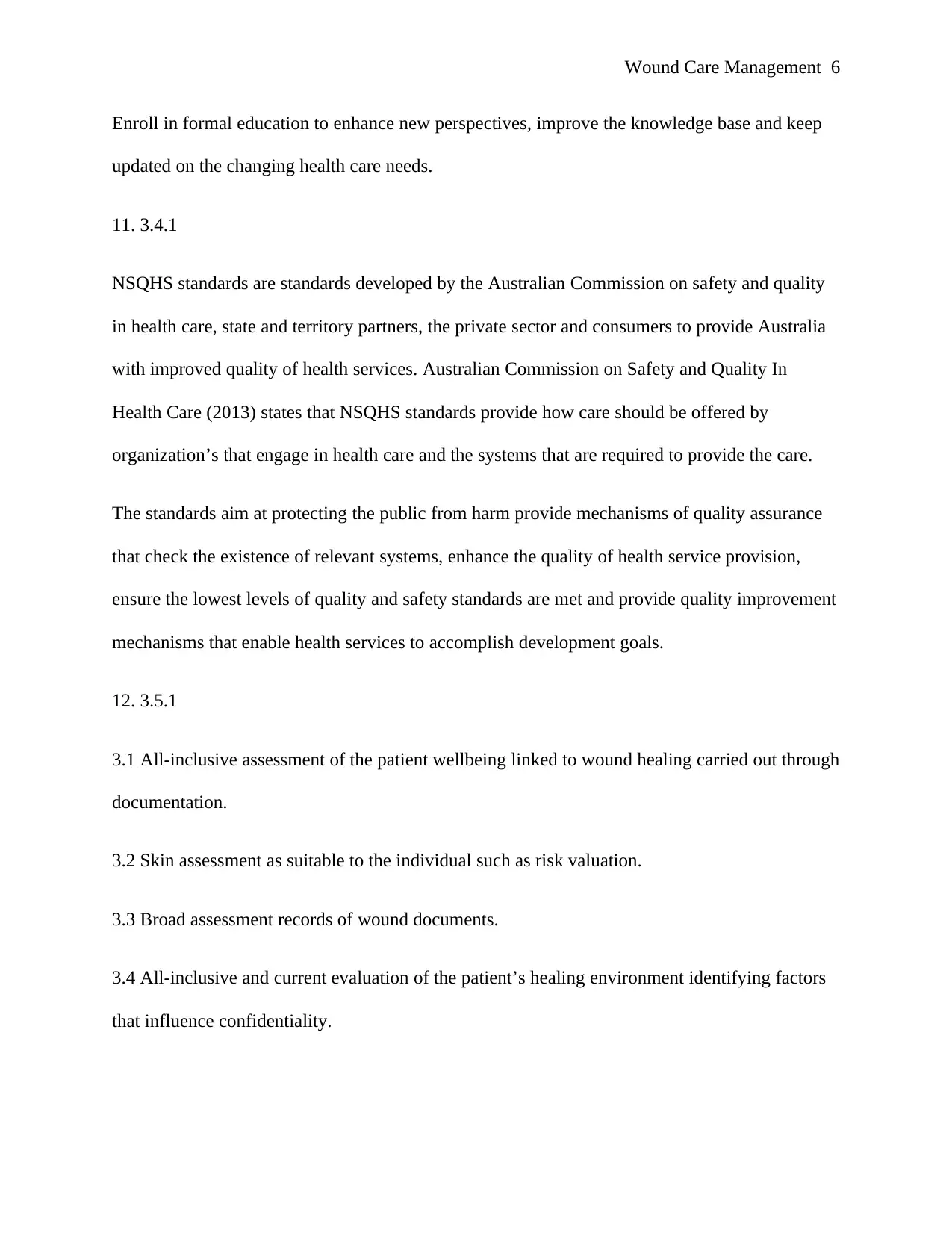
Wound Care Management 6
Enroll in formal education to enhance new perspectives, improve the knowledge base and keep
updated on the changing health care needs.
11. 3.4.1
NSQHS standards are standards developed by the Australian Commission on safety and quality
in health care, state and territory partners, the private sector and consumers to provide Australia
with improved quality of health services. Australian Commission on Safety and Quality In
Health Care (2013) states that NSQHS standards provide how care should be offered by
organization’s that engage in health care and the systems that are required to provide the care.
The standards aim at protecting the public from harm provide mechanisms of quality assurance
that check the existence of relevant systems, enhance the quality of health service provision,
ensure the lowest levels of quality and safety standards are met and provide quality improvement
mechanisms that enable health services to accomplish development goals.
12. 3.5.1
3.1 All-inclusive assessment of the patient wellbeing linked to wound healing carried out through
documentation.
3.2 Skin assessment as suitable to the individual such as risk valuation.
3.3 Broad assessment records of wound documents.
3.4 All-inclusive and current evaluation of the patient’s healing environment identifying factors
that influence confidentiality.
Enroll in formal education to enhance new perspectives, improve the knowledge base and keep
updated on the changing health care needs.
11. 3.4.1
NSQHS standards are standards developed by the Australian Commission on safety and quality
in health care, state and territory partners, the private sector and consumers to provide Australia
with improved quality of health services. Australian Commission on Safety and Quality In
Health Care (2013) states that NSQHS standards provide how care should be offered by
organization’s that engage in health care and the systems that are required to provide the care.
The standards aim at protecting the public from harm provide mechanisms of quality assurance
that check the existence of relevant systems, enhance the quality of health service provision,
ensure the lowest levels of quality and safety standards are met and provide quality improvement
mechanisms that enable health services to accomplish development goals.
12. 3.5.1
3.1 All-inclusive assessment of the patient wellbeing linked to wound healing carried out through
documentation.
3.2 Skin assessment as suitable to the individual such as risk valuation.
3.3 Broad assessment records of wound documents.
3.4 All-inclusive and current evaluation of the patient’s healing environment identifying factors
that influence confidentiality.
⊘ This is a preview!⊘
Do you want full access?
Subscribe today to unlock all pages.

Trusted by 1+ million students worldwide
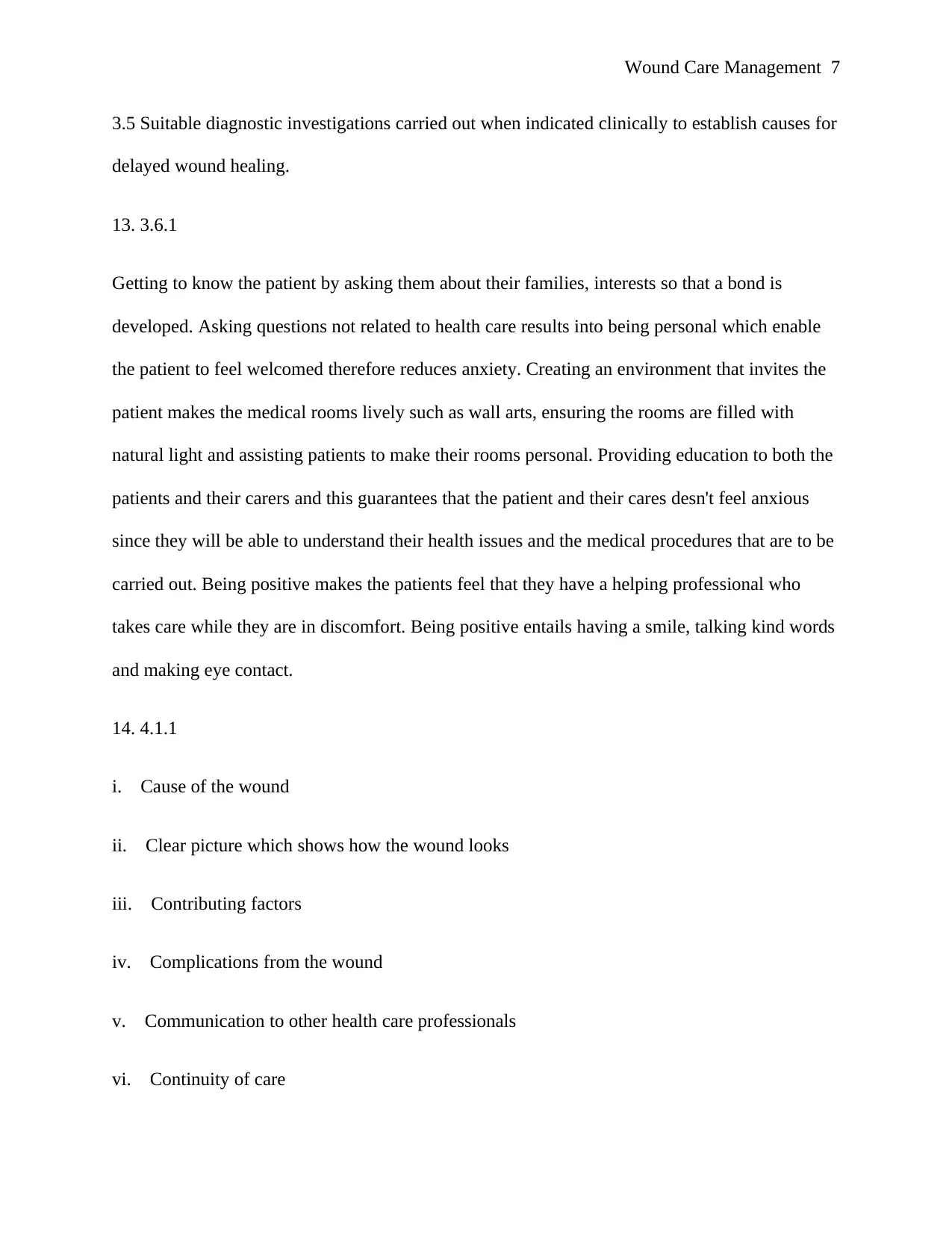
Wound Care Management 7
3.5 Suitable diagnostic investigations carried out when indicated clinically to establish causes for
delayed wound healing.
13. 3.6.1
Getting to know the patient by asking them about their families, interests so that a bond is
developed. Asking questions not related to health care results into being personal which enable
the patient to feel welcomed therefore reduces anxiety. Creating an environment that invites the
patient makes the medical rooms lively such as wall arts, ensuring the rooms are filled with
natural light and assisting patients to make their rooms personal. Providing education to both the
patients and their carers and this guarantees that the patient and their cares desn't feel anxious
since they will be able to understand their health issues and the medical procedures that are to be
carried out. Being positive makes the patients feel that they have a helping professional who
takes care while they are in discomfort. Being positive entails having a smile, talking kind words
and making eye contact.
14. 4.1.1
i. Cause of the wound
ii. Clear picture which shows how the wound looks
iii. Contributing factors
iv. Complications from the wound
v. Communication to other health care professionals
vi. Continuity of care
3.5 Suitable diagnostic investigations carried out when indicated clinically to establish causes for
delayed wound healing.
13. 3.6.1
Getting to know the patient by asking them about their families, interests so that a bond is
developed. Asking questions not related to health care results into being personal which enable
the patient to feel welcomed therefore reduces anxiety. Creating an environment that invites the
patient makes the medical rooms lively such as wall arts, ensuring the rooms are filled with
natural light and assisting patients to make their rooms personal. Providing education to both the
patients and their carers and this guarantees that the patient and their cares desn't feel anxious
since they will be able to understand their health issues and the medical procedures that are to be
carried out. Being positive makes the patients feel that they have a helping professional who
takes care while they are in discomfort. Being positive entails having a smile, talking kind words
and making eye contact.
14. 4.1.1
i. Cause of the wound
ii. Clear picture which shows how the wound looks
iii. Contributing factors
iv. Complications from the wound
v. Communication to other health care professionals
vi. Continuity of care
Paraphrase This Document
Need a fresh take? Get an instant paraphrase of this document with our AI Paraphraser
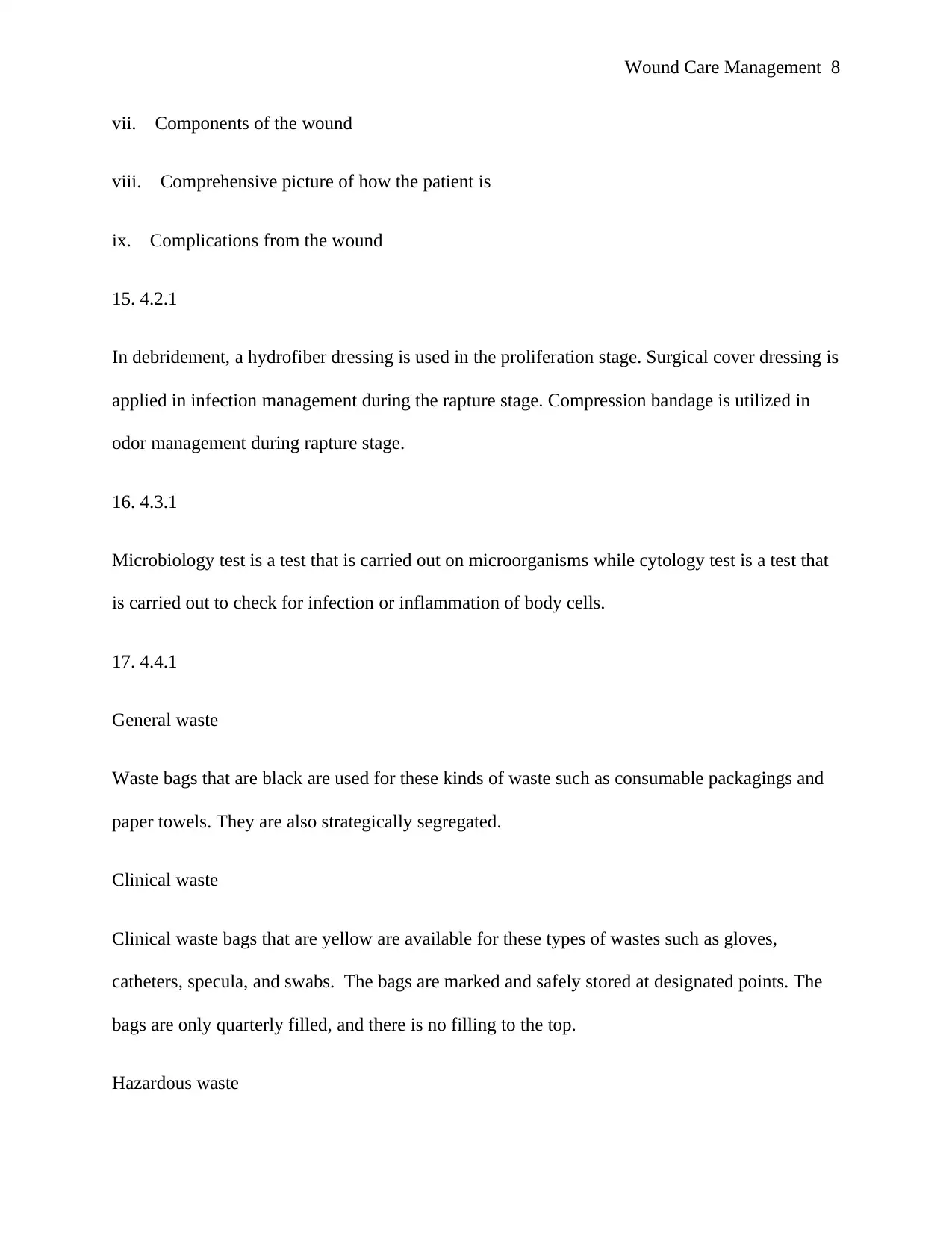
Wound Care Management 8
vii. Components of the wound
viii. Comprehensive picture of how the patient is
ix. Complications from the wound
15. 4.2.1
In debridement, a hydrofiber dressing is used in the proliferation stage. Surgical cover dressing is
applied in infection management during the rapture stage. Compression bandage is utilized in
odor management during rapture stage.
16. 4.3.1
Microbiology test is a test that is carried out on microorganisms while cytology test is a test that
is carried out to check for infection or inflammation of body cells.
17. 4.4.1
General waste
Waste bags that are black are used for these kinds of waste such as consumable packagings and
paper towels. They are also strategically segregated.
Clinical waste
Clinical waste bags that are yellow are available for these types of wastes such as gloves,
catheters, specula, and swabs. The bags are marked and safely stored at designated points. The
bags are only quarterly filled, and there is no filling to the top.
Hazardous waste
vii. Components of the wound
viii. Comprehensive picture of how the patient is
ix. Complications from the wound
15. 4.2.1
In debridement, a hydrofiber dressing is used in the proliferation stage. Surgical cover dressing is
applied in infection management during the rapture stage. Compression bandage is utilized in
odor management during rapture stage.
16. 4.3.1
Microbiology test is a test that is carried out on microorganisms while cytology test is a test that
is carried out to check for infection or inflammation of body cells.
17. 4.4.1
General waste
Waste bags that are black are used for these kinds of waste such as consumable packagings and
paper towels. They are also strategically segregated.
Clinical waste
Clinical waste bags that are yellow are available for these types of wastes such as gloves,
catheters, specula, and swabs. The bags are marked and safely stored at designated points. The
bags are only quarterly filled, and there is no filling to the top.
Hazardous waste
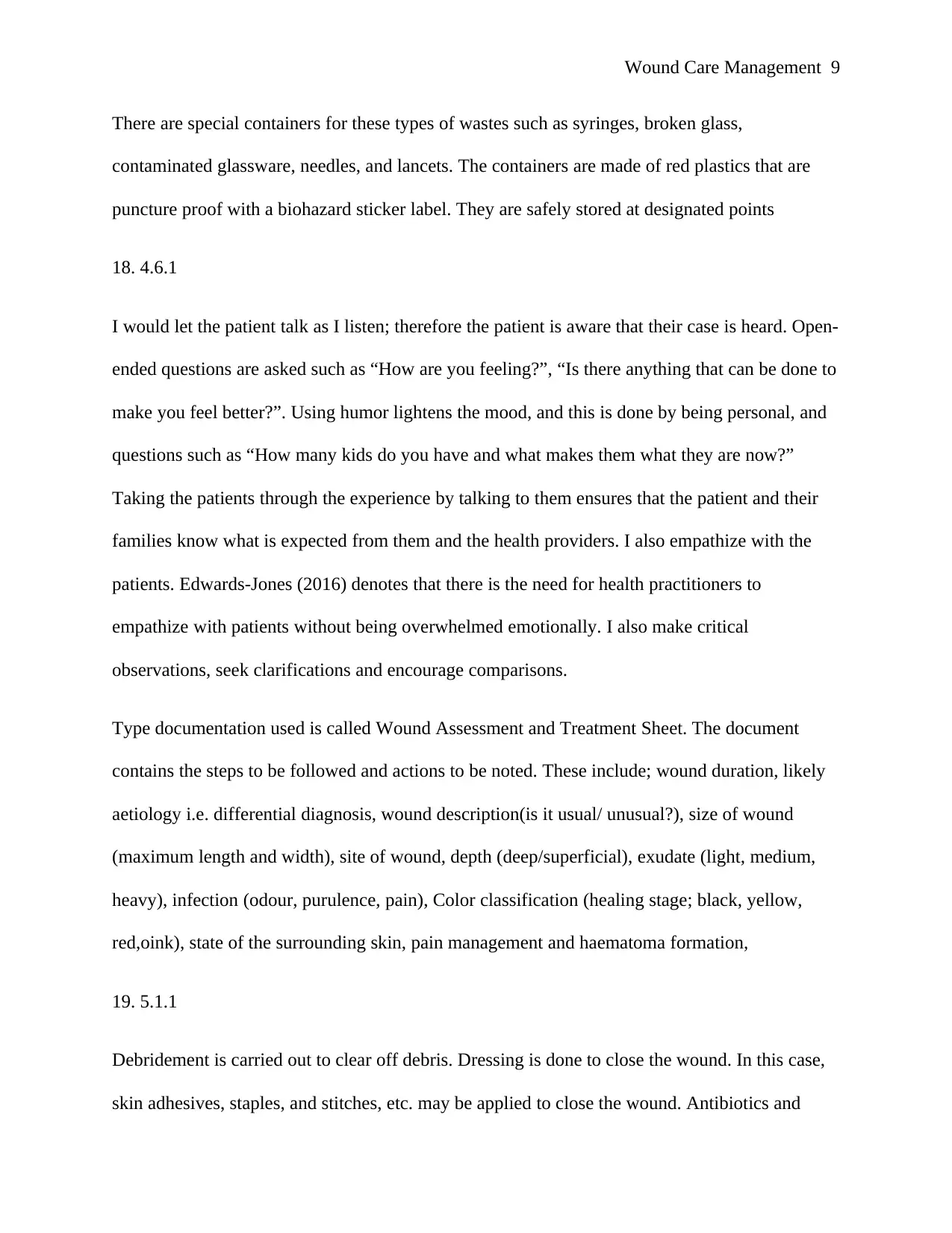
Wound Care Management 9
There are special containers for these types of wastes such as syringes, broken glass,
contaminated glassware, needles, and lancets. The containers are made of red plastics that are
puncture proof with a biohazard sticker label. They are safely stored at designated points
18. 4.6.1
I would let the patient talk as I listen; therefore the patient is aware that their case is heard. Open-
ended questions are asked such as “How are you feeling?”, “Is there anything that can be done to
make you feel better?”. Using humor lightens the mood, and this is done by being personal, and
questions such as “How many kids do you have and what makes them what they are now?”
Taking the patients through the experience by talking to them ensures that the patient and their
families know what is expected from them and the health providers. I also empathize with the
patients. Edwards-Jones (2016) denotes that there is the need for health practitioners to
empathize with patients without being overwhelmed emotionally. I also make critical
observations, seek clarifications and encourage comparisons.
Type documentation used is called Wound Assessment and Treatment Sheet. The document
contains the steps to be followed and actions to be noted. These include; wound duration, likely
aetiology i.e. differential diagnosis, wound description(is it usual/ unusual?), size of wound
(maximum length and width), site of wound, depth (deep/superficial), exudate (light, medium,
heavy), infection (odour, purulence, pain), Color classification (healing stage; black, yellow,
red,oink), state of the surrounding skin, pain management and haematoma formation,
19. 5.1.1
Debridement is carried out to clear off debris. Dressing is done to close the wound. In this case,
skin adhesives, staples, and stitches, etc. may be applied to close the wound. Antibiotics and
There are special containers for these types of wastes such as syringes, broken glass,
contaminated glassware, needles, and lancets. The containers are made of red plastics that are
puncture proof with a biohazard sticker label. They are safely stored at designated points
18. 4.6.1
I would let the patient talk as I listen; therefore the patient is aware that their case is heard. Open-
ended questions are asked such as “How are you feeling?”, “Is there anything that can be done to
make you feel better?”. Using humor lightens the mood, and this is done by being personal, and
questions such as “How many kids do you have and what makes them what they are now?”
Taking the patients through the experience by talking to them ensures that the patient and their
families know what is expected from them and the health providers. I also empathize with the
patients. Edwards-Jones (2016) denotes that there is the need for health practitioners to
empathize with patients without being overwhelmed emotionally. I also make critical
observations, seek clarifications and encourage comparisons.
Type documentation used is called Wound Assessment and Treatment Sheet. The document
contains the steps to be followed and actions to be noted. These include; wound duration, likely
aetiology i.e. differential diagnosis, wound description(is it usual/ unusual?), size of wound
(maximum length and width), site of wound, depth (deep/superficial), exudate (light, medium,
heavy), infection (odour, purulence, pain), Color classification (healing stage; black, yellow,
red,oink), state of the surrounding skin, pain management and haematoma formation,
19. 5.1.1
Debridement is carried out to clear off debris. Dressing is done to close the wound. In this case,
skin adhesives, staples, and stitches, etc. may be applied to close the wound. Antibiotics and
⊘ This is a preview!⊘
Do you want full access?
Subscribe today to unlock all pages.

Trusted by 1+ million students worldwide
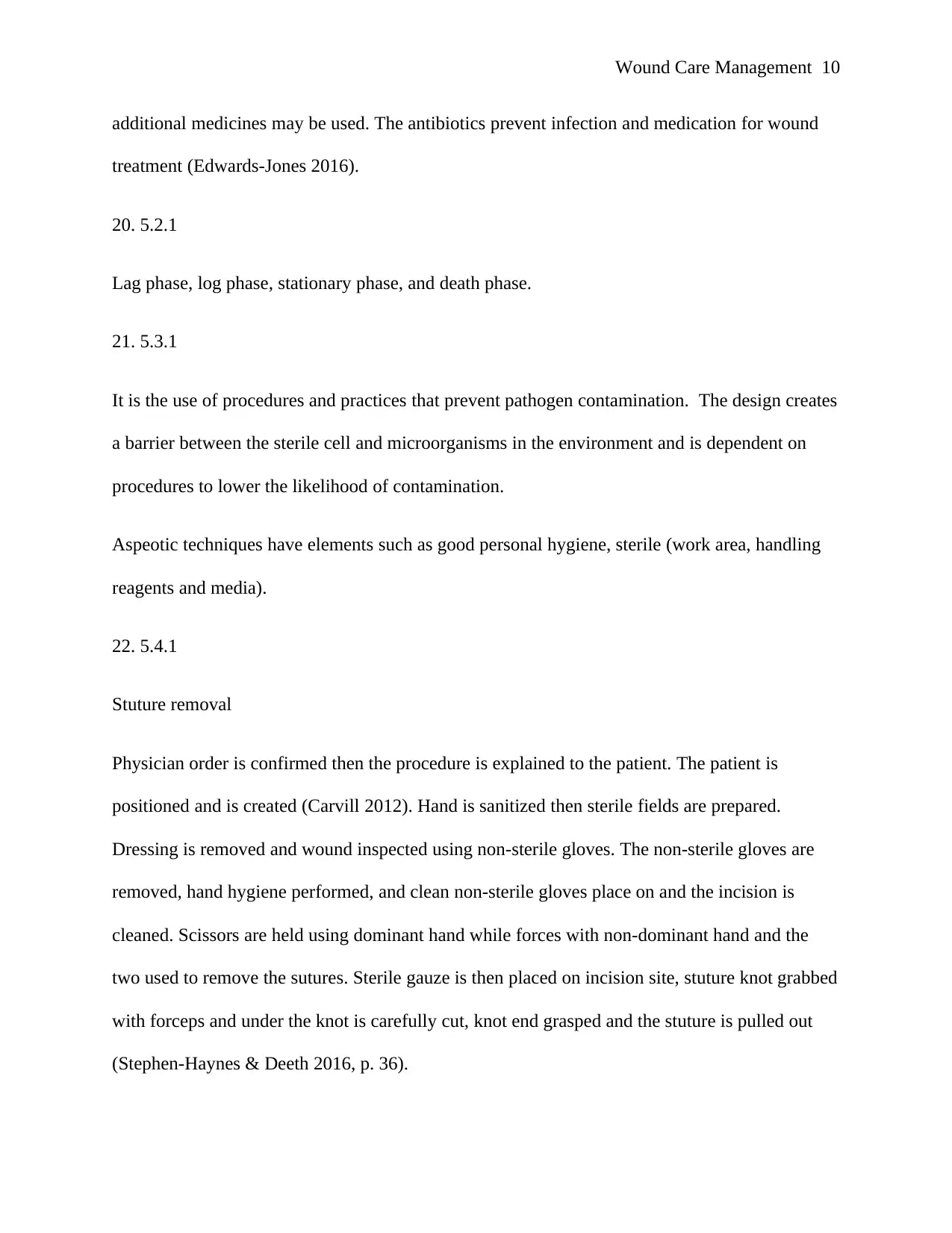
Wound Care Management 10
additional medicines may be used. The antibiotics prevent infection and medication for wound
treatment (Edwards-Jones 2016).
20. 5.2.1
Lag phase, log phase, stationary phase, and death phase.
21. 5.3.1
It is the use of procedures and practices that prevent pathogen contamination. The design creates
a barrier between the sterile cell and microorganisms in the environment and is dependent on
procedures to lower the likelihood of contamination.
Aspeotic techniques have elements such as good personal hygiene, sterile (work area, handling
reagents and media).
22. 5.4.1
Stuture removal
Physician order is confirmed then the procedure is explained to the patient. The patient is
positioned and is created (Carvill 2012). Hand is sanitized then sterile fields are prepared.
Dressing is removed and wound inspected using non-sterile gloves. The non-sterile gloves are
removed, hand hygiene performed, and clean non-sterile gloves place on and the incision is
cleaned. Scissors are held using dominant hand while forces with non-dominant hand and the
two used to remove the sutures. Sterile gauze is then placed on incision site, stuture knot grabbed
with forceps and under the knot is carefully cut, knot end grasped and the stuture is pulled out
(Stephen-Haynes & Deeth 2016, p. 36).
additional medicines may be used. The antibiotics prevent infection and medication for wound
treatment (Edwards-Jones 2016).
20. 5.2.1
Lag phase, log phase, stationary phase, and death phase.
21. 5.3.1
It is the use of procedures and practices that prevent pathogen contamination. The design creates
a barrier between the sterile cell and microorganisms in the environment and is dependent on
procedures to lower the likelihood of contamination.
Aspeotic techniques have elements such as good personal hygiene, sterile (work area, handling
reagents and media).
22. 5.4.1
Stuture removal
Physician order is confirmed then the procedure is explained to the patient. The patient is
positioned and is created (Carvill 2012). Hand is sanitized then sterile fields are prepared.
Dressing is removed and wound inspected using non-sterile gloves. The non-sterile gloves are
removed, hand hygiene performed, and clean non-sterile gloves place on and the incision is
cleaned. Scissors are held using dominant hand while forces with non-dominant hand and the
two used to remove the sutures. Sterile gauze is then placed on incision site, stuture knot grabbed
with forceps and under the knot is carefully cut, knot end grasped and the stuture is pulled out
(Stephen-Haynes & Deeth 2016, p. 36).
Paraphrase This Document
Need a fresh take? Get an instant paraphrase of this document with our AI Paraphraser
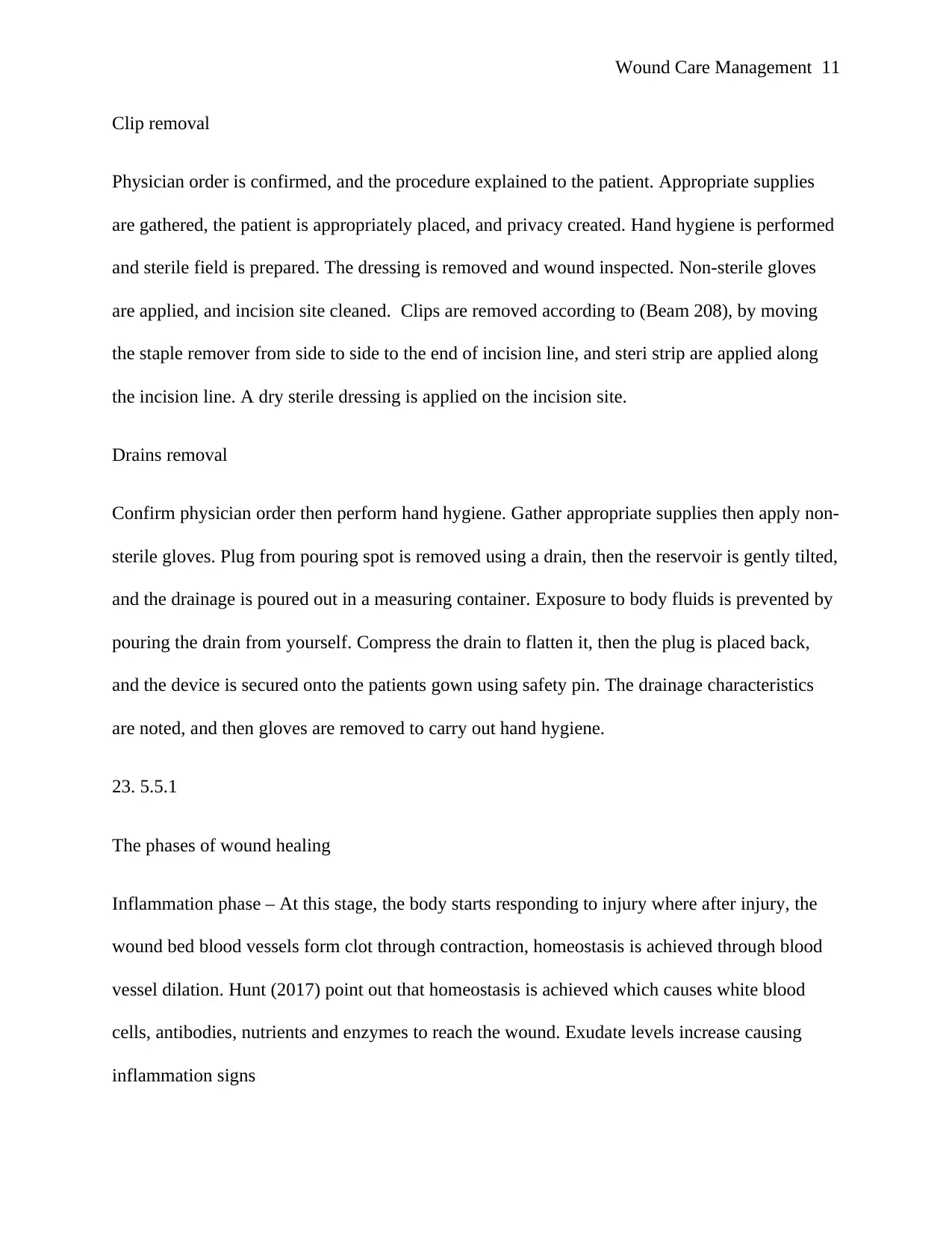
Wound Care Management 11
Clip removal
Physician order is confirmed, and the procedure explained to the patient. Appropriate supplies
are gathered, the patient is appropriately placed, and privacy created. Hand hygiene is performed
and sterile field is prepared. The dressing is removed and wound inspected. Non-sterile gloves
are applied, and incision site cleaned. Clips are removed according to (Beam 208), by moving
the staple remover from side to side to the end of incision line, and steri strip are applied along
the incision line. A dry sterile dressing is applied on the incision site.
Drains removal
Confirm physician order then perform hand hygiene. Gather appropriate supplies then apply non-
sterile gloves. Plug from pouring spot is removed using a drain, then the reservoir is gently tilted,
and the drainage is poured out in a measuring container. Exposure to body fluids is prevented by
pouring the drain from yourself. Compress the drain to flatten it, then the plug is placed back,
and the device is secured onto the patients gown using safety pin. The drainage characteristics
are noted, and then gloves are removed to carry out hand hygiene.
23. 5.5.1
The phases of wound healing
Inflammation phase – At this stage, the body starts responding to injury where after injury, the
wound bed blood vessels form clot through contraction, homeostasis is achieved through blood
vessel dilation. Hunt (2017) point out that homeostasis is achieved which causes white blood
cells, antibodies, nutrients and enzymes to reach the wound. Exudate levels increase causing
inflammation signs
Clip removal
Physician order is confirmed, and the procedure explained to the patient. Appropriate supplies
are gathered, the patient is appropriately placed, and privacy created. Hand hygiene is performed
and sterile field is prepared. The dressing is removed and wound inspected. Non-sterile gloves
are applied, and incision site cleaned. Clips are removed according to (Beam 208), by moving
the staple remover from side to side to the end of incision line, and steri strip are applied along
the incision line. A dry sterile dressing is applied on the incision site.
Drains removal
Confirm physician order then perform hand hygiene. Gather appropriate supplies then apply non-
sterile gloves. Plug from pouring spot is removed using a drain, then the reservoir is gently tilted,
and the drainage is poured out in a measuring container. Exposure to body fluids is prevented by
pouring the drain from yourself. Compress the drain to flatten it, then the plug is placed back,
and the device is secured onto the patients gown using safety pin. The drainage characteristics
are noted, and then gloves are removed to carry out hand hygiene.
23. 5.5.1
The phases of wound healing
Inflammation phase – At this stage, the body starts responding to injury where after injury, the
wound bed blood vessels form clot through contraction, homeostasis is achieved through blood
vessel dilation. Hunt (2017) point out that homeostasis is achieved which causes white blood
cells, antibodies, nutrients and enzymes to reach the wound. Exudate levels increase causing
inflammation signs
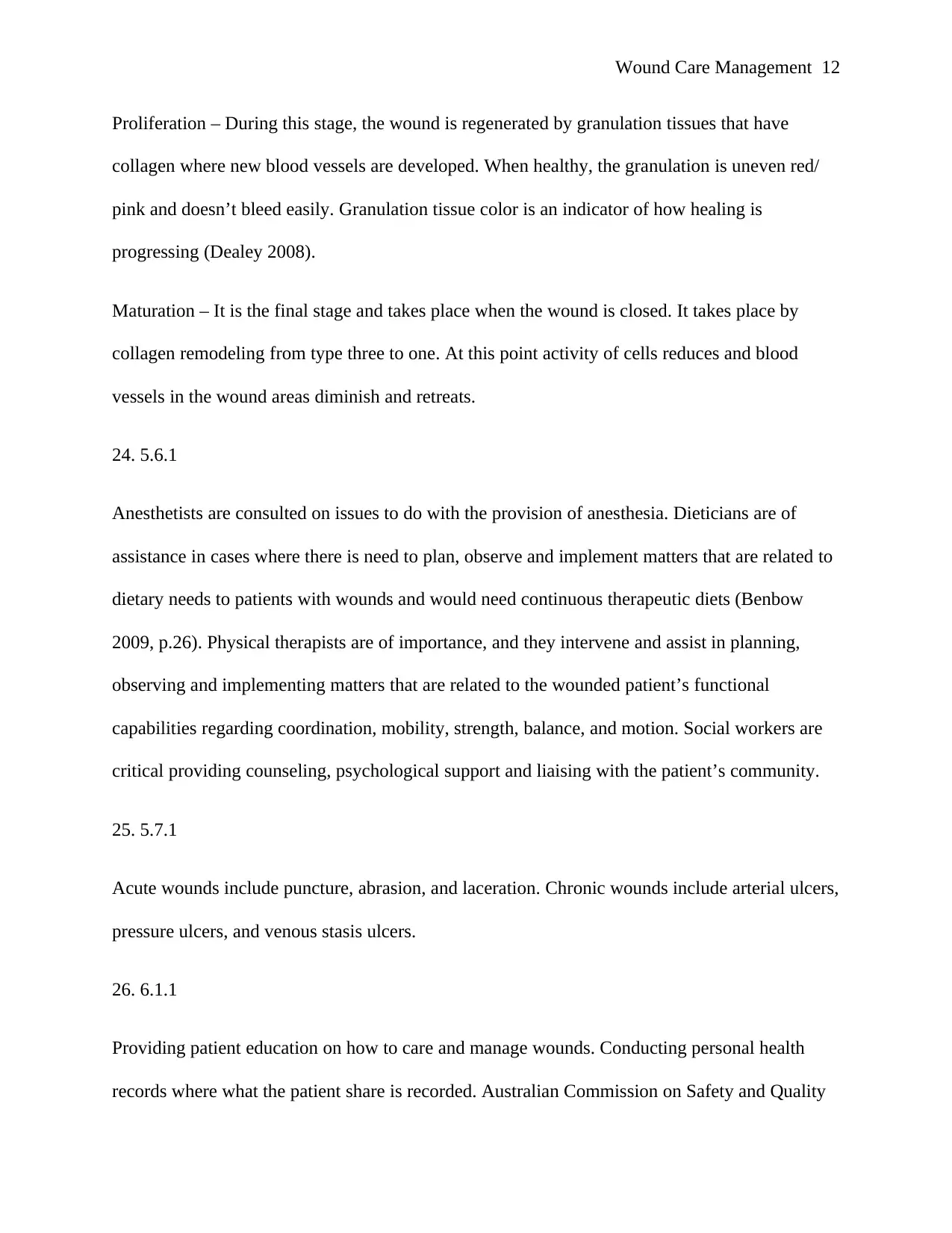
Wound Care Management 12
Proliferation – During this stage, the wound is regenerated by granulation tissues that have
collagen where new blood vessels are developed. When healthy, the granulation is uneven red/
pink and doesn’t bleed easily. Granulation tissue color is an indicator of how healing is
progressing (Dealey 2008).
Maturation – It is the final stage and takes place when the wound is closed. It takes place by
collagen remodeling from type three to one. At this point activity of cells reduces and blood
vessels in the wound areas diminish and retreats.
24. 5.6.1
Anesthetists are consulted on issues to do with the provision of anesthesia. Dieticians are of
assistance in cases where there is need to plan, observe and implement matters that are related to
dietary needs to patients with wounds and would need continuous therapeutic diets (Benbow
2009, p.26). Physical therapists are of importance, and they intervene and assist in planning,
observing and implementing matters that are related to the wounded patient’s functional
capabilities regarding coordination, mobility, strength, balance, and motion. Social workers are
critical providing counseling, psychological support and liaising with the patient’s community.
25. 5.7.1
Acute wounds include puncture, abrasion, and laceration. Chronic wounds include arterial ulcers,
pressure ulcers, and venous stasis ulcers.
26. 6.1.1
Providing patient education on how to care and manage wounds. Conducting personal health
records where what the patient share is recorded. Australian Commission on Safety and Quality
Proliferation – During this stage, the wound is regenerated by granulation tissues that have
collagen where new blood vessels are developed. When healthy, the granulation is uneven red/
pink and doesn’t bleed easily. Granulation tissue color is an indicator of how healing is
progressing (Dealey 2008).
Maturation – It is the final stage and takes place when the wound is closed. It takes place by
collagen remodeling from type three to one. At this point activity of cells reduces and blood
vessels in the wound areas diminish and retreats.
24. 5.6.1
Anesthetists are consulted on issues to do with the provision of anesthesia. Dieticians are of
assistance in cases where there is need to plan, observe and implement matters that are related to
dietary needs to patients with wounds and would need continuous therapeutic diets (Benbow
2009, p.26). Physical therapists are of importance, and they intervene and assist in planning,
observing and implementing matters that are related to the wounded patient’s functional
capabilities regarding coordination, mobility, strength, balance, and motion. Social workers are
critical providing counseling, psychological support and liaising with the patient’s community.
25. 5.7.1
Acute wounds include puncture, abrasion, and laceration. Chronic wounds include arterial ulcers,
pressure ulcers, and venous stasis ulcers.
26. 6.1.1
Providing patient education on how to care and manage wounds. Conducting personal health
records where what the patient share is recorded. Australian Commission on Safety and Quality
⊘ This is a preview!⊘
Do you want full access?
Subscribe today to unlock all pages.

Trusted by 1+ million students worldwide
1 out of 27
Related Documents
Your All-in-One AI-Powered Toolkit for Academic Success.
+13062052269
info@desklib.com
Available 24*7 on WhatsApp / Email
![[object Object]](/_next/static/media/star-bottom.7253800d.svg)
Unlock your academic potential
Copyright © 2020–2025 A2Z Services. All Rights Reserved. Developed and managed by ZUCOL.





